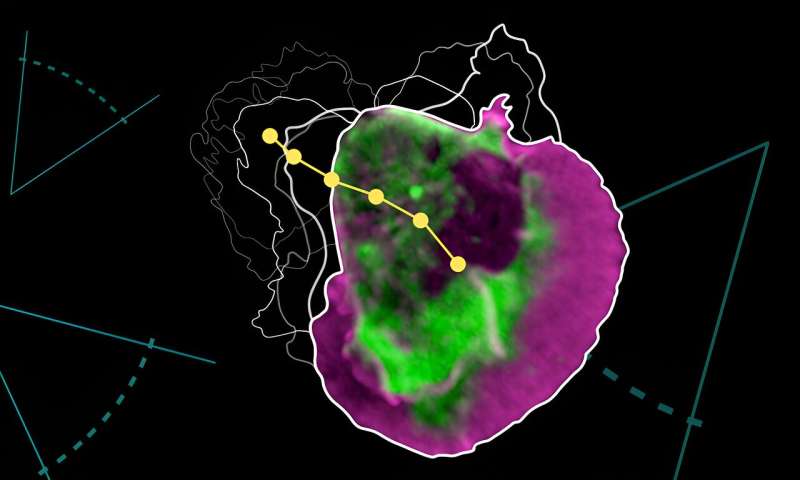This article has been reviewed according to Science X's editorial process and policies. Editors have highlighted the following attributes while ensuring the content's credibility:
fact-checked
peer-reviewed publication
trusted source
proofread
Understanding how cells avoid obstacles while navigating complex environments

Imagine a dark room packed full of furniture. Now imagine moving through it to get to the other side, using only your toe tips for guidance. While it may seem challenging (or unspeakably tedious) to us, this is a task that many cells in our body perform regularly while migrating through tissues. New research from the Diz-Muñoz group at EMBL Heidelberg has now identified a novel molecular pathway that helps cells achieve this feat.
Cells often move by first extending a part of their outer membrane and cytoplasm in a chosen direction. This protrusion, called the "leading edge," is highly dynamic at first but settles as the cell slowly builds up the underlying skeletal structure. This "cytoskeleton," formed by filaments of a protein called actin, helps stabilize the leading edge and allows the rest of the cell to move in that direction.
However, things get tricky when the leading edge encounters an obstacle, like another cell or a physical barrier. Alba Diz-Muñoz's group at EMBL studies how mechanical interactions at the surface of the cell regulate its behaviors. "We have something of a material scientist's view on biology," Diz-Muñoz said. "Physical properties like fluidity, viscosity, and curvature, particularly at the membrane interface, can influence how a cell reacts to its environment. However, not much is known about how this is coordinated at the molecular level."
In the new study, published in Nature Communications, Diz Muñoz's team has identified a protein—Snx33—as a critical regulator of the process by which cells arrest the progress of the leading edge upon encountering an obstacle. Snx33 belongs to a large family of proteins called BAR-domain proteins, which are known for their ability to sense the curvature of membranes.
When a cell hits an obstacle, the leading edge flattens as a result of this interaction, thus changing the curvature. Through a series of elegant experiments, the researchers showed how Snx33 responds to this change by recruiting molecular machinery that helps inhibit the actin cytoskeleton. This, in turn, helps the cell slowly dissolve the leading edge and make progress in a different direction. Cells from which Snx33 had been genetically deleted, therefore, were slower in navigating environments that were crowded or had barriers.
There are several currently known BAR-domain proteins, which are highly conserved in animal cells. "From our observations, a picture emerges where the diversity of BAR-domain proteins could allow the cells to decode and react to the information from membrane curvature in unique ways, allowing for quick and complex reactions to various environmental stimuli," said Ewa Sitarska, first author of the study and a former Ph.D. student in the Diz-Muñoz lab.
Diz-Muñoz believes that given the ubiquitousness of BAR-domain proteins, other migrating cell types might also use similar navigational mechanisms. This can be highly relevant not only for immune cells, like the neutrophil-like cells from this study, but also for metastasizing tumor cells, embryonic cells during development, or even free-living single-celled microbes.
"We have identified a molecular gatekeeper which basically tells the cell: 'You've hit an obstacle, go elsewhere,'" said Diz-Muñoz. "I think the general principle—of sensing curvature and activating downstream molecular pathways—might apply at much wider length and time scales, perhaps even at the level of tissues."
The study involved collaborations with a number of other EMBL groups, including Anna Erzberger, Anna Kreshuk, and Yannick Schwab's groups at EMBL Heidelberg, and Jan Kosinski's group at EMBL Hamburg.
The study also provides impetus for further investigations on curvature-sensing proteins. "Mammalian cells have over 80 different proteins assumed to be sensing curvature and more are still being discovered," said Sitarska. "Our work provides a hint to how important and widespread this process is. Most of these proteins are still poorly understood and thus, provide a very interesting subject of research."
More information: Ewa Sitarska et al, Sensing their plasma membrane curvature allows migrating cells to circumvent obstacles, Nature Communications (2023). DOI: 10.1038/s41467-023-41173-1
Journal information: Nature Communications
Provided by European Molecular Biology Laboratory



















